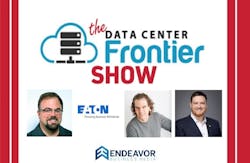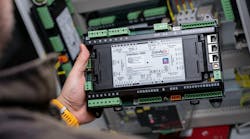Inside the Evolving Power and Purpose of AI Data Centers: A Conversation with Eaton’s Doug Kilgariff and JP Buzzell
As AI workloads redefine the scale and shape of digital infrastructure, the foundational questions for data center design are being rewritten in real time. In the latest episode of the Data Center Frontier Show, Eaton’s Doug Kilgariff, Strategic Accounts Manager for Data Centers, and JP Buzzell, VP and Data Center Chief Architect, joined us to map the pressure points, opportunities, and forward-looking strategies in today’s data center industry.
Together, we unpacked how artificial intelligence is disrupting the rules of engagement for everything from power provisioning to workforce planning, and why modularity, liquid cooling, and purpose-built design are becoming non-negotiable for future-proofed operations.
AI at the Center of Data Center Change
Both Eaton data center experts agreed that AI isn’t just an emerging workload; it’s an architectural disruptor. According to Buzzell and Kilgariff, AI is arriving in two distinct formats: retrofitted into existing facilities and as the nucleus of purpose-built AI data halls.
The difference in approach is stark:
- Retrofits demand a surgical focus on egress, density, and power/cooling retro-compatibility.
- Purpose-built AI halls, on the other hand, are designed in reverse, beginning with the computational load and building out the infrastructure to meet it.
As GPU clusters scale beyond H100-class workloads (think the AMD MI325X or NVIDIA’s GB200) liquid cooling is no longer a luxury but a prerequisite. Eaton is zeroing in on the electrical backbone needed to support these cooling systems, particularly in dense environments.
The Hidden Gap Between Design and Reality
“There’s always a delta between shop drawings and as-builts,” Kilgariff noted, and in today’s AI environments, that margin of error is shrinking fast. A single foot of deviation in containment can ripple through the entire mechanical and electrical system.
Liquid cooling adds complexity, not only from an engineering standpoint but in real-world implementation. Tight coordination around pipe placement, containment, and electrical room modularization is essential, especially when speed-to-revenue is critical.
Eaton is seeing strong customer demand for modular electrical rooms, enabling faster delivery and reducing risk in high-stakes builds. This approach is also helping address construction labor shortages in major metros where multiple hyperscale campuses break ground simultaneously.
From Colocation to Crusoe: The New Customer Typology
Buzzell offered a nuanced view of evolving customer segments. “What used to be a clear line between colocation and hyperscale is now a spectrum,” he explained. To wit: Colocation providers are now frequently building to hyperscaler specifications, while new players (such as Crusoe Energy) are deploying massive, campus-scale compute infrastructure globally.
These trends are influencing both site selection and power strategies. Traditional hubs like Northern Virginia and Phoenix are increasingly constrained by power limitations. As a result, developers are turning to tertiary markets - such as Ohio, Idaho, even Louisiana - where land, fiber, and megawatts are still available.
Tax abatements and behind-the-meter power solutions are rising in importance. Eaton is actively collaborating with Siemens Energy to explore modular natural gas-powered generation, advancing what Buzzell called the “eyeballs → fiber → electrons → molecules” evolution in site selection logic.
Project Management as the Glue
Speed and success in this environment depend not just on engineering, but on flawless execution and communication. Eaton has invested in a dedicated Project Management Organization (PMO) to bring cohesion to projects from design to site turnover. The PMO ensures that timelines, stakeholder responsibilities, and milestone tracking are aligned throughout a project’s lifecycle.
“Good project management doesn’t just keep things on time,” Buzzell emphasized. “It prevents problems before they become delays.”
Metrics and Efficiency in a Modular, Liquid Future
Despite the shifting tech landscape, the Eaton experts noted that Power Usage Effectiveness (PUE) remains relevant in the data center, so long as it’s applied with correct boundary conditions. Stranded assets, including underutilized cooling and electrical systems, are a growing concern. Modern KPIs like True Usage Effectiveness (TUE) and asset utilization metrics offer a clearer lens on operational efficiency.
Eaton’s approach remains focused on building power and cooling ecosystems that don’t just function, but which scale, integrate, and endure.
Addressing the Workforce Squeeze
Labor remains a critical bottleneck. Kilgariff cited startling numbers: over 300,000 electricians and 20,000 MEP (Mechanical, Electrical, Plumbing) roles are needed to support current data center demand. That doesn’t include factory labor to support manufacturing cycles.
Eaton is addressing the gap with targeted partnerships across high schools and community colleges, offering data center-specific programming and pathways into skilled trades. As multiple hyperscale projects rise in the same geographies, this pipeline is more vital than ever.
Eaton’s Data Center Vision: A Learning Lab for the Future
To stay ahead of these accelerating dynamics, Eaton is doubling down on dialogue. Their annual Data Center Vision event acts as both seminar and industry think tank, gathering operators, engineers, and strategists to share insights and plan for what’s next.
The event’s agenda includes updates on supply chain resiliency, modular innovations, and power solutions for AI workloads. As Buzzell put it, “It’s not just about where we are now - it’s about aligning for what’s coming five years from now.”
Final Word
This episode offers a compelling, hands-on look at how Eaton is adapting and leading in a world where AI is not just another application: increasingly, it’s the blueprint. From liquid-cooled electrical rooms to natural gas microgrids and reimagined workforce pipelines, Eaton’s vision for the data center is pragmatic, forward-thinking, and refreshingly execution-focused.
Recent DCF Show Podcast Episodes
-
Flexential CEO Chris Downie on the Data Center Industry's AI, Cloud Paradigm Shifts
-
ark data centers CEO Brett Lindsey Talks Colocation Rebranding for Edge, AI Initiatives
-
CyrusOne CEO Eric Schwartz Talks AI Data Center Financing, Sustainability
-
Prometheus Hyperscale Pushes Data Center Horizons to 1 GW
-
Quantum Corridor CEO Tom Dakich On U.S. Midwest Data Center Horizons
Did you like this episode? Be sure to subscribe to the Data Center Frontier show at Podbean to receive future episodes on your app.
At Data Center Frontier, we talk the industry talk and walk the industry walk. In that spirit, DCF Staff members may occasionally use AI tools to assist with content. Elements of this article were created with help from OpenAI's GPT4.
Keep pace with the fast-moving world of data centers and cloud computing by connecting with Data Center Frontier on LinkedIn, following us on X/Twitter and Facebook, as well as on BlueSky, and signing up for our weekly newsletters using the form below.
About the Author
Matt Vincent
A B2B technology journalist and editor with more than two decades of experience, Matt Vincent is Editor in Chief of Data Center Frontier.



